Stocked up on food in your kitchen but unable to find anything? While most homes in Pakistan stock up on the bare essentials, including flour, rice, sugar, tea, and a range of spices, very few of us organise the dry food ingredients smartly. This results in a chaotic storage area. So, how can you store food in the kitchen in an organised manner? Let’s find out
Top Tips to Store Food in the Kitchen
A cluttered food storage cupboard or pantry can make you miss out on expiry dates, make it a chore to create a shopping list for groceries, and force you to overspend on items you already have stocked up in the back. Here are some food storage ideas for your kitchen to help you cut down on the clutter and make the storage area more organised:
- Declutter the Storage Area
- Create an Inventory of What You Have
- Use the ‘First In, First Out’ Rule
- Store Similar Items Together
- Move Your Food Items to Containers
- Label Your Jars Right
- Store Food Items According to Height and Weight
- Plan for Non-Food Items
- Give Easy Access to Healthy Snacks
- Try Some Additional Storage Tips and Tricks
- Organise Your Pantry Regularly
Now, let’s discuss each of these ways to organise your kitchen and your food storage area in detail.
Declutter the Storage Area
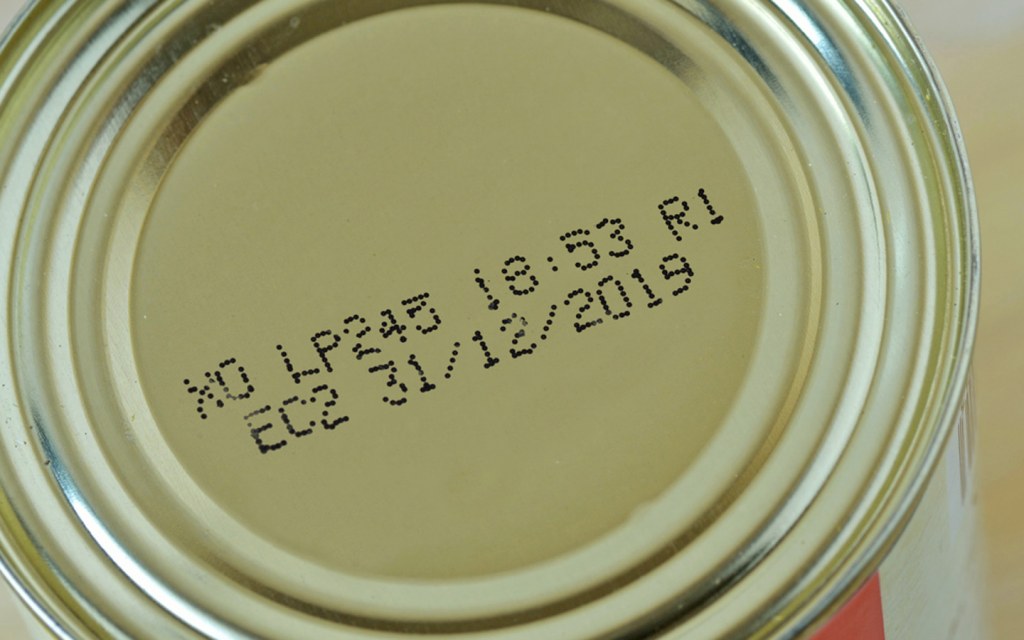
Irrespective of whether you have a dedicated storage area or pantry for your dry food ingredients, or whether you have dedicated a few cupboards in your kitchen for stocked food, we’ve all been in a situation where a box has been pushed to the back and expired before we got a chance to use its contents.
Thus, the first step to store food in the kitchen is to take everything out of its dedicated space and check expiries on everything. Throw away all expired food, spices, and ingredients. You can also separate food items that are close to expiry but will not get used in your household before then. These can be donated to charity. For example, if you know that a big box of cereal is not going to be consumed in the next week and will expire by then, consider donating it or giving it to a needy person, including your hired house help.
Decluttering your pantry includes cleaning the space in the cupboard or shelves where you’ll be stocking the food, including checking the space for moisture, pests, and insects, as all of these circumstances can damage your stocked groceries.
Create an Inventory of What You Have
Once you’ve thrown away all the expired products and donated what you’re not going to use, it’s time to take stock of what’s available. Categorise your food items. You can group canned food together, spices in one group, sauces in another, juices or soft drinks together, and so on. Ideally, you should jot down the inventory on a notepad or paper and stick it to the inside of your storage cupboard. Here are some of the major categories of food items to consider:
- Dry goods, such as flour, tea, sugar, grains, rice, and so on.
- Canned goods
- Jars and bottles, including jams and sauces
- Packaged food boxes, such as cereal, pasta, crackers, cake mixes, etc.
- Spices, boxes as well as jars
- Beverages, including juices, soft drink cans, and bottles
- Root vegetables, such as onions, potatoes, and garlic, which are not stored in the refrigerator
- Pet food and treats if you have a furry friend to feed
- Snacks for kids and adult alike, including biscuits, chips, and sweets
Categorising your food items in this way will help you figure out if you already own duplicates of certain items of varying expiry dates. You’ll also be able to mark items you need spares of and shop for them accordingly.
Use the ‘First In, First Out’ Rule
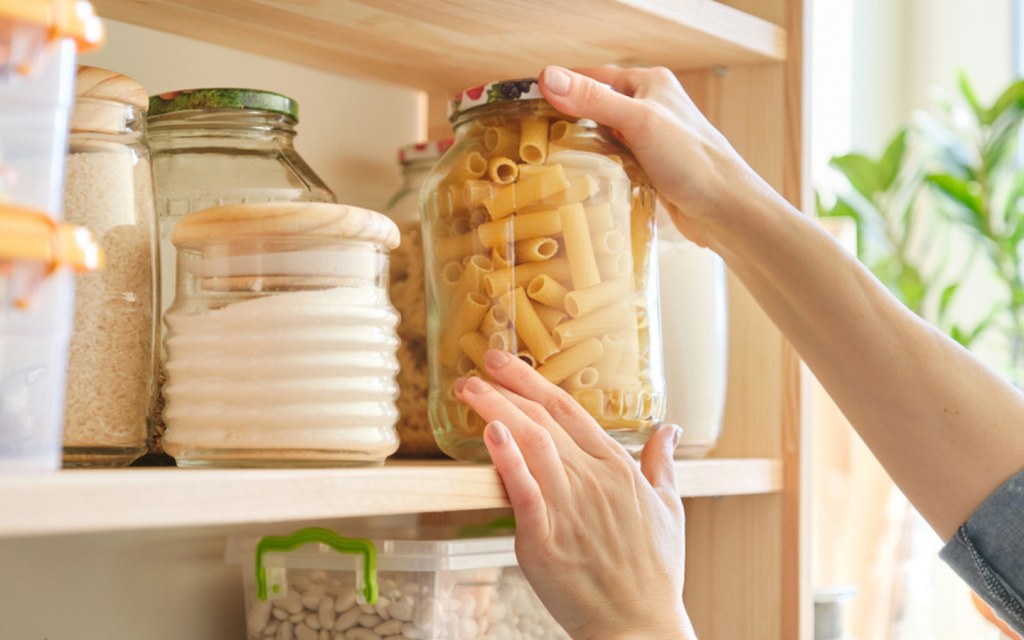
Now, before you implement any of our smart kitchen storage ideas, you should know about the ‘first in, first out’ rule. This means that items that are bought recently will be the last ones to be used. The logic behind the rule is that duplicate items, bought at a later date, will generally have longer expiries, so the first box of cereal that you bought is to be consumed first, and the second one acts as a spare until needed.
It is important that you organise your pantry based on this rule, and place all newly bought groceries at the back or at the side so that you have convenient access to the older ones first. Check expiries for all your products before you store them, so you can use them accordingly.
Store Similar Items Together
Now we come to the method of storing food in your kitchen. You’ve categorised your food items already and checked expiries for duplicates. The trick to organising your food smartly is to now arrange the cupboard or shelves, keeping similar items from the same group together. Keeping ‘like with like’ will not only make it easier to store the food but also enable you to save space and avoid awkward empty corners. It also becomes a lot easier to find a particular item within your cupboard if you know that you’ve stored it with other items of the same group.
When you’re storing food in your kitchen, you also need to consider the frequency of use of each item. You might not use a cake mix box regularly, but require the box of cereals daily. Similarly, some spices are ideal for daily use, while others can be pushed to the back since they are used occasionally.
Convenience is also another aspect to consider in this regard. If you require sugar, tea, cereal, or coffee every morning for breakfast, you might require access to the spare box or jar in your pantry urgently as you’re running late for work. Thus, items of daily use must be placed at the front or in a separate shelf where they are easily accessible.
One thing to remember is that not all items make good neighbours. Storing strong spices with cake mixes and flour is not a good idea, as the flour and dry ingredients will absorb the smell of the spices. Similarly, potatoes and onions both come from the ground but keep them together in the same basket, and you’ll ruin them faster. Onions and garlic, however, can easily stay together in the basket or bag.
Move Your Food Items to Containers
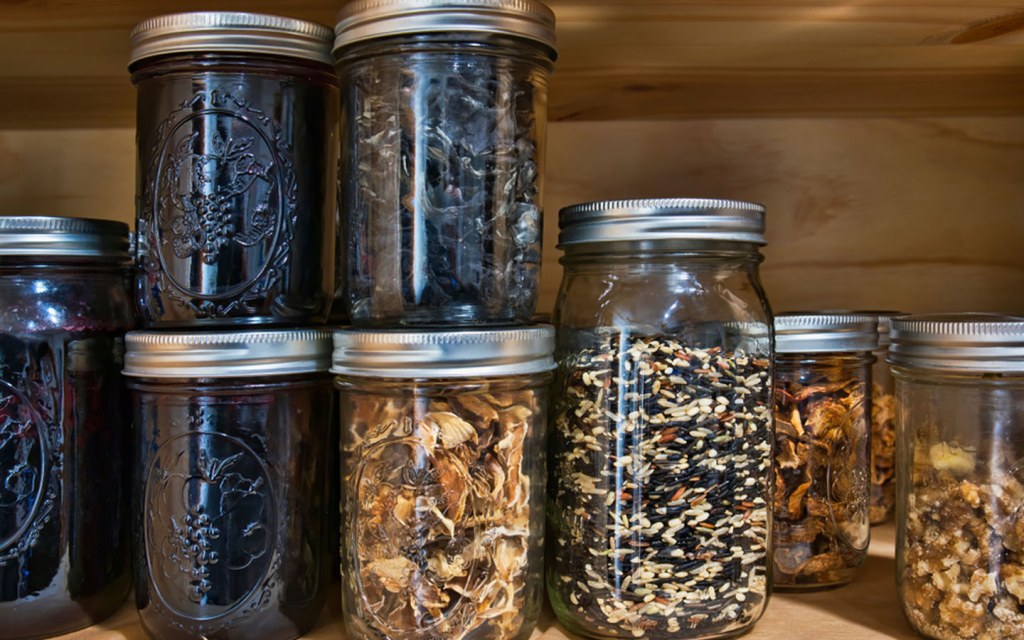
Keeping dry ingredients in their original packaging over time can result in an insect or pest infestation. Thus, one of the many ways to organise your kitchen is to transfer the dry spices, flour, sugar, rice, and other ingredients into jars and storage cylinders. This not only adds to the aesthetic appeal of your pantry but also keeps your food from spoiling. Make sure you keep the lids closed on all of the jars to avoid attracting pests.
Additionally, if you like to measure out flour or rice using a cup or a mug, opt for jars with wider mouths, which enable you to easily measure out ingredients as per your preference.
Label Your Jars Right
You’re asked to label your food items every time you store food in the kitchen, especially when you move it into jars and containers, but guess what? You might have been doing it wrong! While it is always helpful to know what you’ve stored in a jar, the most important thing to note is the expiry date.
You also do not need a fancy sticker label for this task. Simply use a strip of paper tape over your glass jars and a marker to note down both the name of the product and its ‘Best Before’ date.
Store Food Items According to Height and Weight
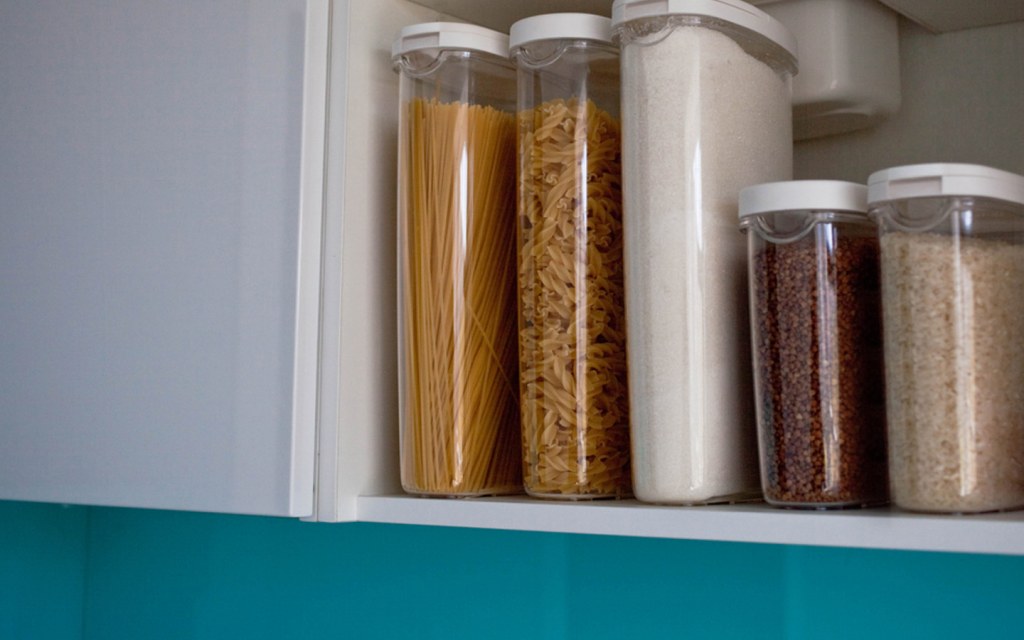
One of the smart kitchen organisation hacks is to always place taller items at the back of the shelf or cupboard and to keep shorter bottles, jars, and boxes at the front, so the taller items do not hinder your visibility of the items stocked at the back. You might need a separate shelf for taller boxes if they cannot fit into your existing cupboard. You can also try laying the boxes down horizontally on top of one another if they’re sturdy enough.
Moreover, heavier jars will require sturdier shelves. They’ll also need to be placed on lower levels, with lighter items at the top shelves. This will help balance out the weight on the shelves. You should also avoid stacking all the heavy items in one corner of the shelf, just to be on the safe side. Divide the weight evenly across the available space.
Plan for Non-Food Items
You’ll rarely see appliances decorating countertops in homes in Pakistan. In most cases, people prefer to use a shelf or a cupboard specifically for small appliances. So, if you’ve decided to dedicate part of your food storage area to your toaster, sandwich maker, grinder, juicer, or blender, you’ll need to plan out the storage space accordingly.
It is recommended that you keep your appliances in a separate cupboard or shelf within your storage space so that they do not hinder your access to the edible goods.
Give Easy Access to Healthy Snacks
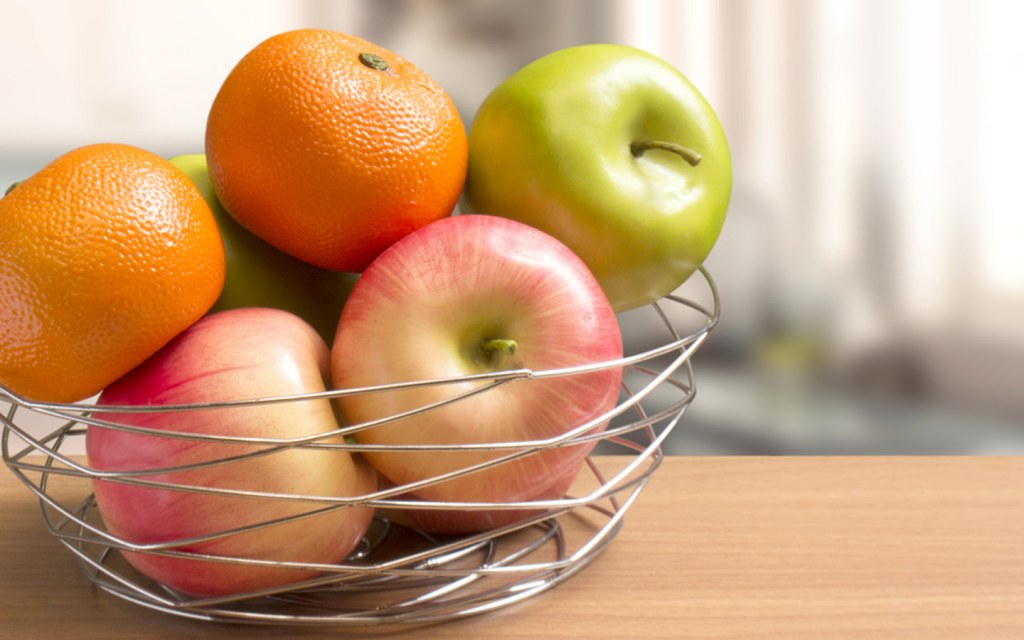
Smart kitchen organisation hacks include providing your kids with easy access to healthy snacks for their mid-day hunger pangs. While you might store chocolates and sweets on higher shelves out of reach, stock up on crackers, fruit, cereals, and other healthy meals in one of the lower drawers or shelves in your kitchen so that your young ones can have a snack easily.
Try Some Additional Storage Tips and Tricks
Still looking for amazing food storage ideas? Check out the ones we’ve shared below:
- Make sure that all your jars and canisters have airtight lids to ensure freshness of the ingredients kept inside
- Use baskets for fruits and vegetables that you’re keeping at room temperature
- Use a spice rack for your essential spices if you want a stylish alternative to individual jars
- You can use pieces of cardboard to separate storage areas and organise kitchen cabinets
- Choose a cool and dry area to store your food, so that it retains its life for longer
- Rather than leaving boxes or packets open inside the pantry, move the contents to jars instead
Organise Your Pantry Regularly
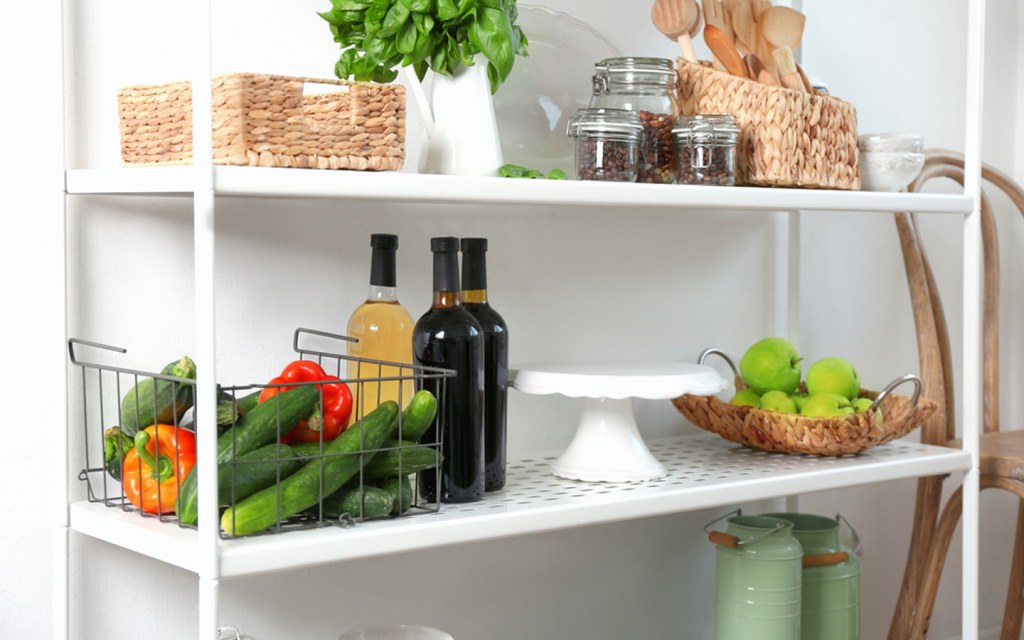
You’ll easily be able to store food in the kitchen smartly using these tips and tricks. But know that this organisation will need to be maintained. Otherwise, your pantry will be chaotic in a few weeks time. From rechecking expiries to dusting the shelves and adding new items to the stock when you buy groceries every month, there’s a lot to be done to keep your pantry looking neat and organised. Ideally, take a look at the storage area every two weeks and restock every time you take out the last spare box or the packet of a particular item.
You can organise the dry food ingredients smartly if you keep a check on what’s being brought into the house, and store it immediately, accordingly to the system you have in place, rather than letting items pile up at the front of the shelf until you can no longer see what’s hidden behind them. Stay vigilant and stay organised to avoid a messy kitchen.
Keep reading more DIY posts on Zameen Blog. We are also just an email away at blog@zameen.com for all your suggestions.



